Finding the Leader in Yourself: 35 Years of T³™ Mentorship and Community
Posted 01/30/2023 by TI Staff
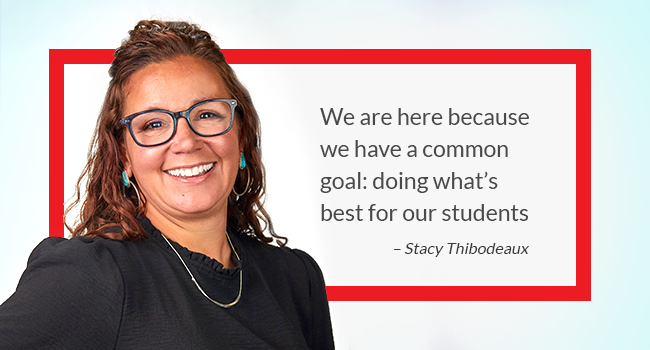
Stacy Thibodeaux paused to collect her emotions. “It’s been an honor being a part of the T³™ community,” she said, speaking to a room full of educators at the Texas Instruments 2022 T³™ Learns Summit. “It allows us to push each other and to grow and develop. And, we have a common goal: the success of our students.”
In 2022, Thibodeaux was one of four individuals recognized with the T³™ Leadership Award, an award recognizing the outstanding contributions of a T³™ instructor for the T³™ community.

35 years of teachers teaching teachers
This year is the 35th anniversary of the T³™ professional development organization, founded by two professors, Bert K. Waits and Franklin Demana of The Ohio State University. Their early efforts were focused on precalculus education.
The first Computers and Calculators in Precalculus (C²PC) conference in 1988 welcomed 80 teachers from around the nation to participate in training sessions — the precursor to the T³™ International Conference (T³IC). By 1990, C²PC had expanded to 12 states, and in 1992, the program was officially renamed to Teachers Teaching with Technology™ (T³™) professional development.
Over the years, the organization has grown. More than 120,000 educators have attended T³™ events. Since its inception, over 500 educators, like Thibodeaux, have also taken a step further to become a T³™ instructor.
Today, T³™ instruction supports middle grades and high school math, science and STEM teachers with not only T³IC, but also webinars, workshops and regional summits. In addition, the organization offers systemic coaching and develops teacher leaders through the T³™ Teacher Leader Cadre (TLC).

All you need is a temperature sensor
In 2013, Thibodeaux was an AP® Biology teacher working at a STEM magnet school. That year, her school received a GEAR UP grant, and she was put in charge of spending the money.
Her principal approached her and said, “Hey — let’s get these [TI-Nspire™ CX graphing calculators and TI-Nspire™ CX Navigator™ Systems]. Oh, and why don’t we go to the conference [T³IC] too?” They took two math teachers, an assistant principal, and herself, Thibodeaux recalled.
“[T³IC] was literally the best conference I have ever been to, not just because of the community, but because of the way they treat teachers. Nobody treats teachers like Texas Instruments does.”
Thibodeaux found herself sitting in the front row of a session taught by Jeff Lukens, a T³™ instructor and science teacher. It was a simple session just using a Vernier temperature sensor. But, Thibodeaux was hooked, and she proceeded to attend every session Lukens taught throughout the conference.
“What got me, was how the technology was used to make a connection between math and science. It wasn’t just a focus on the technology, it was a focus on student investigation,” Thibodeaux explained.
“Seeing the math concept bring the science to life was a real aha! I knew it was going to be meaningful for the students too.”
At the time, this was a big component Thibodeaux felt she was missing from her teaching practice. She said, “I was just teaching content then. This helped me see the connections.”
To this day, Thibodeaux carries a temperature sensor with her constantly. “If I have my laptop and my sensor, I can teach any kind of lesson using TI technology.”
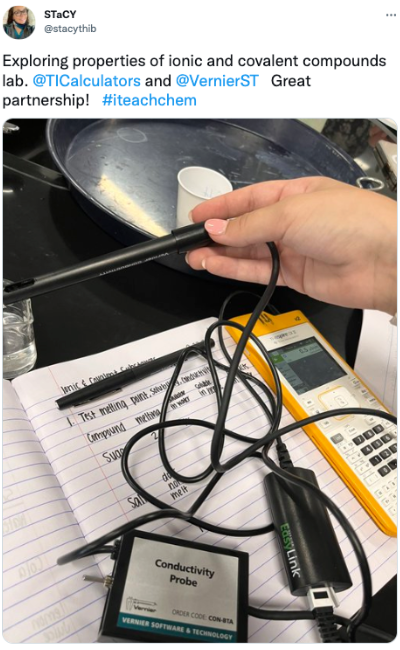

A mentorship begins
Not surprisingly, Lukens noticed Thibodeaux’s enthusiasm (it is contagious). They connected at the conference and struck up a friendship. Soon enough, they were communicating back and forth and, with Lukens’ encouragement, Thibodeaux set up a class set of TI-Nspire™ CX graphing calculators and Vernier sensors in her classroom.
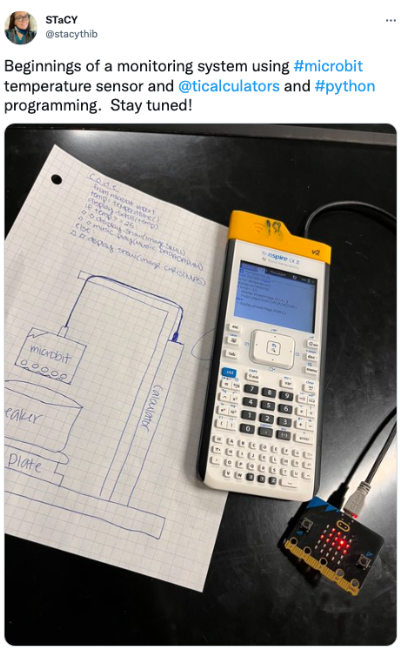
When the next T³™ TLC enrollment opened that fall, Lukens encouraged Thibodeaux to apply. At first, she felt a bit intimidated.
“I can’t do all of this math stuff. I’m a science teacher.”
But, Lukens kept at her. He explained that T³™ benefits from passionate educators such as Thibodeaux. "As an instructor that passion to work with students and willingness to work with a calculator and technology would help lead a lot of science teachers who may shy away from this."
Lukens’ words helped, but Thibodeaux was also hungry for knowledge for herself and her teammates. Thibodeaux realized, “I wanted more training and to know more about the technology.”
“[T³™ TLC] was a way for me to learn more but also bring back those learnings to the teachers at my school.”
So, she submitted her application and was accepted into the 2014 TLC program.

Sharing a common goal: the students
At first glance, a T³™ TLC might feel a bit daunting.
It’s a total of nine days of professional learning with three days of in-person, hands-on, face-to-face instruction (usually in the summer). The remaining instruction is held online, generally in two-hour segments, over the school year. These virtual meetings cover math or science concepts, leadership skills and qualities, or best practices and current strategies in math, science and STEM education.
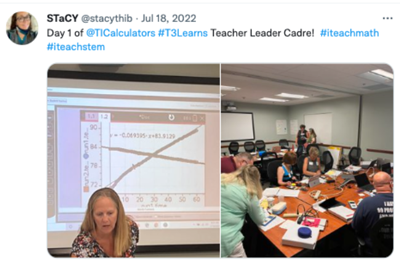
From elementary teachers to university professors, their backgrounds include public, private, charter and magnet schools, as well as urban, suburban and rural environments. All of these educators in the same room have the same goal: to do what's best for the students.
“You are in a room with other like-minded people. Everybody wants to grow and learn together. It can be hard to find that same mindset within the four walls of your school.”
After a T³™ TLC , some find they want to become T³™ instructors as well. It’s the next step from mentee to mentor. Educators must present at a conference and be evaluated. Special attention is given to the transition from teaching students to leading and teaching adults. Time is taken to reflect on personal goals as a practitioner and where they fit into the T³™ community.
“Even if someone doesn’t become a T³™ instructor, they are making lifelong friends here.”
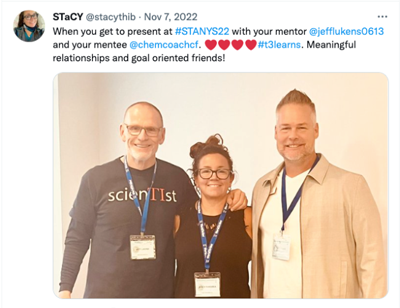
“This summer [2023], I am leading a [T³™] TLC with Katie Martinez from California. I would never have met her if it had not been for T³™ [professional development]. We talk once a week now, not just about teaching but about our kids and life,” Thibodeaux shared.
Apply for the next T³™ TLC

Finding a niche in the classroom
Over the years, Thibodeaux’s classroom has changed and evolved, partially due to the continuing education and experiences she gets through the T³™ community.
Lukens is still a friend and mentor to Thibodeaux and encouraged her to find her niche. “For me, it was adding a robotics class — maybe not a traditional robotics class — it’s very much a STEM projects class. It’s all we do. It’s powerful to find your niche.”
Thibodeaux’s classes have a large focus on STEM projects. She finds these lessons allow for productive struggle for her students. When the students get stuck, they have to troubleshoot.
“A lot of times in education, students just want the right answer. You will never get opportunity to just have the right answer in the real world. Being able to troubleshoot and problem-solve is the rest of your life.”
Thibodeaux recalled another piece of advice Lukens imparted to her: “Yes, as educators, we want these high test scores, but really your job is to prepare students for whatever their ‘next’ is, be it a biologist, pre-med, military, or a wife or father.”
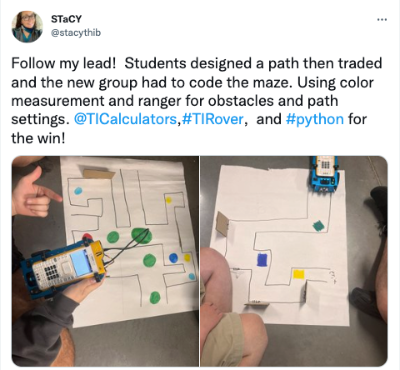
Being a T³™ instructor has also empowered Thibodeaux to grow as a facilitator of learning. She is constantly immersed in education research and best practices from fellow T³™ instructors, keeping her up to date in education standards. Thibodeaux is also quick to share her soapbox — she is no longer a “siloed” teacher.
“I don’t just teach chemistry. I don’t just teach robotics. I teach students the skills that are necessary to get them to the next level, which just happens to include chemistry and robotics and using some really cool technology.”
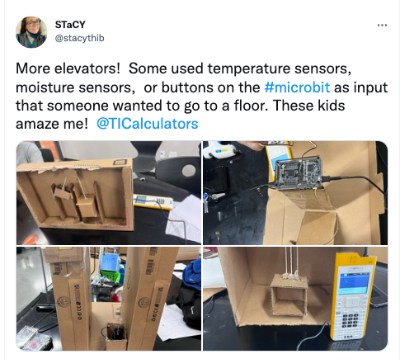
“I’m also not limited to the resources within the four walls of my school.” She continued, “I can call, text and email the relationships I’ve made in [the] T³™ [community], in the States and overseas. We can test, troubleshoot and refine ideas and lessons together. These things, I feel, have made me a better teacher.”
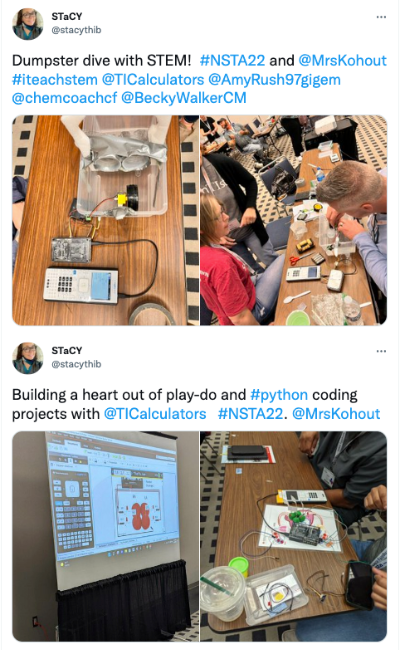

Next step: finding the leader in yourself
The T³™ community is waiting for you. TI is hosting two T³™ TLCs coming up this summer. You can apply until April 3, 2023. Successful applicants will be notified by April 28, 2023.
There is no cost for this T³™ TLC instruction. Plus, TI covers your hotel and meals. You just need to get yourself there.
“I wanted to be a better teacher because I have kids in front of me. I need to be better for them. I tell my students all the time, ‘The only person I compare myself to is the person I was yesterday.’”
Follow Stacy Thibodeaux on Twitter to see more awesome student projects, words of encouragement, and possibly to find your new mentor.
About: Stacy Thibodeaux is a T³™ National Instructor. She holds a Bachelor of Science in biology and chemistry and a master’s degree in educational leadership from the University of Louisiana at Lafayette. She is currently at Southside High School in Youngsville, Louisiana, where she teaches all levels of chemistry I and II. She uses TI technology in her Introduction to Robotics course and to assist her teaching, data collection, and modeling math concepts, linking them to science content.
AP® is a trademark registered by the College Board, which is not affiliated with, and does not endorse, TI products. Policies subject to change.Visit www.collegeboard.org.
